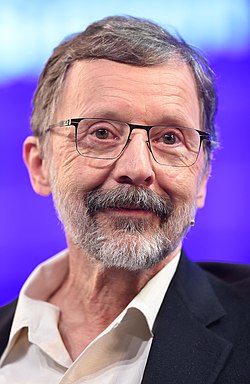Early career
In 1974, Catmull earned his doctorate in computer science, [2] and was hired by a company called Applicon. By November of that year, he had been contacted by Alexander Schure, the founder of the New York Institute of Technology, who offered him the position as the director of the institute's new Computer Graphics Lab. [19] [20] In that position, in 1977, he invented Tween, software for 2D animation that automatically produced frames of motion in between two frames.
However, Catmull's team lacked the ability to tell a story effectively via film, harming the effort to produce a motion picture via a computer. Catmull and his partner, Alvy Ray Smith, attempted to reach out to studios to alleviate this issue, but were generally unsuccessful until they attracted the attention of George Lucas at Lucasfilm.
Lucasfilm
Lucas approached Catmull in 1979 and asked him to lead a group to bring computer graphics, video editing, and digital sound into the entertainment field. Lucas had already made a deal with a computer company called Triple-I, and asked them to create a digital model of an X-wing fighter from Star Wars , which they did. In 1979, Catmull became the Vice President at Lucasfilm, set up to launch a "computer division" inside the company. By 1980 he had established three projects and recruited experts to lead them: the graphics group led by Alvy Ray Smith; the audio project led by Andy Moorer; the nonlinear editing project, led by Ralph Guggenheim. [24] [25]
Pixar
In 1986, Steve Jobs bought Lucasfilm's digital division and founded Pixar, where Catmull works. Pixar would be acquired by Disney in 2006.
In June 2007, Catmull and long-time Pixar digital animator and director John Lasseter were given control of Disneytoon Studios, a division of Walt Disney Animation housed in a separate facility in Glendale. As president and chief creative officer, respectively, they have supervised three separate studios for Disney, each with its own production pipeline: Pixar, Disney Animation, and Disneytoon. While Disney Animation and Disneytoon are located in the Los Angeles area, Pixar is located over 350 miles (563 kilometers) northwest in the San Francisco Bay Area, where Catmull and Lasseter both live. Accordingly, they appointed a general manager for each studio to handle day-to-day affairs on their behalf, then began regularly commuting each week to both Pixar and Disney Animation and spending at least two days per week (usually Tuesdays and Wednesdays) at Disney Animation. [28]
While at Pixar, Catmull was implicated in the High-Tech Employee Antitrust scandal, in which Bay Area technology companies allegedly agreed, among other things, not to cold-call recruit from one another. [29] [30] [31] Catmull defended his actions in a deposition, saying: "While I have responsibility for the payroll, I have responsibility for the long term also." [32] [33] Disney and its subsidiaries, including Pixar, ultimately paid $100 million in settlement compensation. [29] [30]
In November 2014, the general managers of Disney Animation and Pixar were both promoted to president, but both continued to report to Catmull, who retained the title of president of Walt Disney and Pixar. [34] On October 23, 2018, Catmull announced his plans to retire from Pixar and Disney Animation, staying on as an adviser through July 2019. [35]
